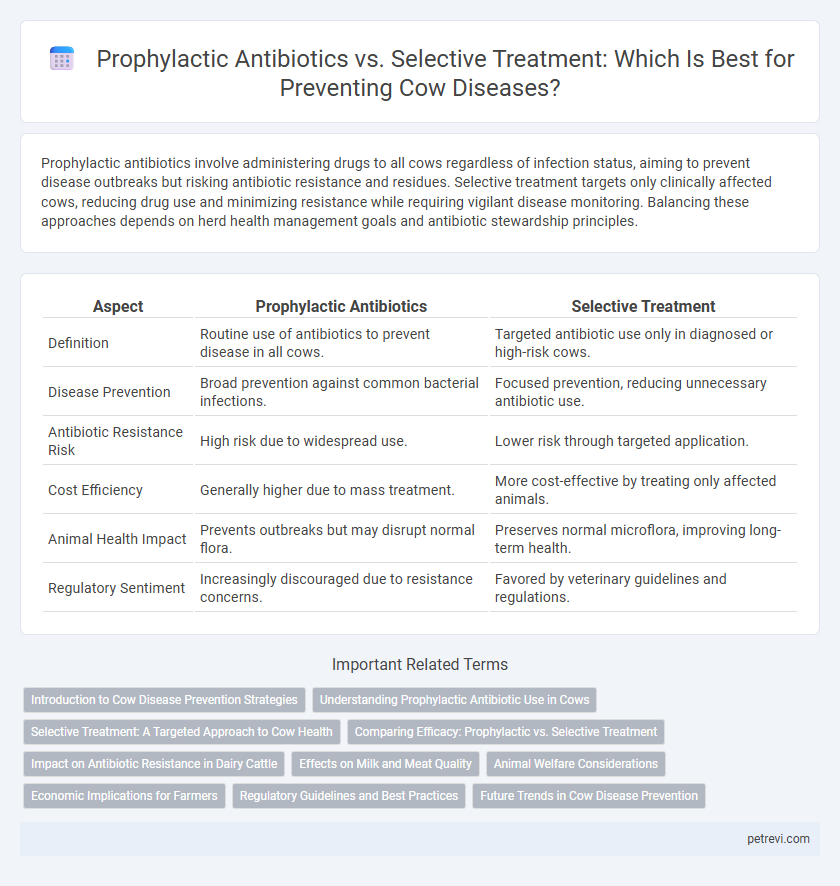Prophylactic antibiotics involve administering drugs to all cows regardless of infection status, aiming to prevent disease outbreaks but risking antibiotic resistance and residues. Selective treatment targets only clinically affected cows, reducing drug use and minimizing resistance while requiring vigilant disease monitoring. Balancing these approaches depends on herd health management goals and antibiotic stewardship principles.
Table of Comparison
| Aspect | Prophylactic Antibiotics | Selective Treatment |
|---|---|---|
| Definition | Routine use of antibiotics to prevent disease in all cows. | Targeted antibiotic use only in diagnosed or high-risk cows. |
| Disease Prevention | Broad prevention against common bacterial infections. | Focused prevention, reducing unnecessary antibiotic use. |
| Antibiotic Resistance Risk | High risk due to widespread use. | Lower risk through targeted application. |
| Cost Efficiency | Generally higher due to mass treatment. | More cost-effective by treating only affected animals. |
| Animal Health Impact | Prevents outbreaks but may disrupt normal flora. | Preserves normal microflora, improving long-term health. |
| Regulatory Sentiment | Increasingly discouraged due to resistance concerns. | Favored by veterinary guidelines and regulations. |
Introduction to Cow Disease Prevention Strategies
Prophylactic antibiotics involve administering antibiotics to healthy cows to prevent disease onset, aiming to reduce infection rates across the herd. Selective treatment targets only cows showing clinical signs or specific risk factors, minimizing antibiotic use and reducing resistance development. Effective cow disease prevention strategies balance maintaining herd health with responsible antibiotic stewardship to optimize long-term productivity.
Understanding Prophylactic Antibiotic Use in Cows
Prophylactic antibiotic use in cows involves administering antibiotics before the onset of disease to prevent infections, particularly in high-risk herds or during stressful periods such as calving. This approach aims to reduce incidences of mastitis, respiratory infections, and other bacterial diseases, but it raises concerns about antibiotic resistance and residues in dairy products. Selective treatment, by contrast, targets only clinically affected animals, promoting responsible antibiotic stewardship and minimizing the risk of resistance development.
Selective Treatment: A Targeted Approach to Cow Health
Selective treatment in cow disease prevention targets only animals exhibiting symptoms or identified as high-risk, minimizing antibiotic use and reducing antimicrobial resistance. This approach relies on precise diagnostics and health monitoring to ensure timely intervention, improving overall herd health management. Selective treatment supports sustainable farming practices by maintaining effective disease control without unnecessary drug exposure.
Comparing Efficacy: Prophylactic vs. Selective Treatment
Prophylactic antibiotics in cows aim to prevent disease outbreaks by administering medication to healthy animals, often reducing incidence rates but raising concerns about antibiotic resistance. Selective treatment targets only symptomatic cows, maintaining herd health while minimizing antibiotic use and resistance development. Studies show selective treatment can be equally effective when combined with robust herd management and monitoring protocols.
Impact on Antibiotic Resistance in Dairy Cattle
Prophylactic antibiotics in dairy cattle often lead to increased antibiotic resistance by exposing a broad bacterial population to continuous drug pressure, which favors resistant strain development. Selective treatment targets only clinically affected cows, reducing unnecessary antibiotic use and thereby slowing the emergence of resistant pathogens in the herd. Evidence from multiple studies shows farms using selective treatment have lower resistance gene prevalence compared to those routinely administering prophylactic antibiotics.
Effects on Milk and Meat Quality
Prophylactic antibiotic use in cows can lead to antibiotic residues in milk and meat, potentially impacting quality and consumer safety. Selective treatment, targeting only affected animals, helps maintain higher milk purity and reduces the risk of antibiotic resistance. Studies show selective treatment preserves both milk flavor and meat tenderness better than widespread prophylactic administration.
Animal Welfare Considerations
Prophylactic antibiotics in cows may prevent disease outbreaks but raise concerns about antibiotic resistance and disruption of natural microbiota, impacting long-term animal health and welfare. Selective treatment targets only clinically affected individuals, promoting responsible antibiotic use and preserving gut flora integrity, which supports overall cow wellbeing. Emphasizing selective treatment aligns with sustainable livestock management and enhances animal welfare by minimizing unnecessary medication exposure.
Economic Implications for Farmers
Prophylactic antibiotics in cow disease prevention often lead to increased short-term expenses but reduce the risk of widespread infection, potentially lowering long-term treatment costs and production losses. Selective treatment targets only diagnosed cases, minimizing drug use and costs, but it may result in higher disease incidence, negatively impacting milk yield and overall herd health. Farmers must weigh the economic trade-offs between upfront prophylactic investment and variable selective treatment outcomes to optimize herd profitability.
Regulatory Guidelines and Best Practices
Regulatory guidelines emphasize minimizing prophylactic antibiotic use in cows to combat antimicrobial resistance, promoting selective treatment based on veterinary diagnosis and specific disease risk factors. Best practices include regular health monitoring, targeted therapy only when infections are confirmed, and integrated herd management strategies to maintain animal welfare while adhering to strict withdrawal periods. Compliance with regional regulations such as the FDA's Veterinary Feed Directive in the U.S. or the EMA's guidelines in Europe ensures responsible antibiotic stewardship in dairy and beef production systems.
Future Trends in Cow Disease Prevention
Future trends in cow disease prevention emphasize the reduction of prophylactic antibiotics to combat antimicrobial resistance, shifting toward selective treatment protocols based on precise diagnostics and individual animal health assessments. Advances in genomic technologies and real-time health monitoring enable targeted interventions, enhancing cow welfare while minimizing unnecessary antibiotic use. Integration of precision livestock farming tools and data analytics supports sustainable disease management strategies, promoting optimal productivity and public health safety in dairy and beef production systems.
Prophylactic antibiotics vs Selective treatment for Cow disease prevention Infographic

 petrevi.com
petrevi.com